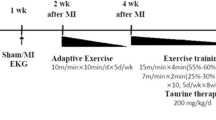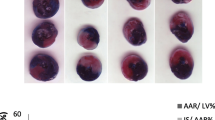Abstract
Objective
Physical activity has been shown to improve cardiovascular function and to be beneficial to type 2 diabetic patients. However, the effects of aerobic exercise (AE) on myocardial ischemia/reperfusion (MI/R) are largely unclear. Therefore, the aims of the present study were to determine whether long-term AE can protect the heart against I/R injury, and if so, to investigate the underlying mechanism.
Methods
Adult male Sprague–Dawley rats were randomly subjected to 8 weeks of either sedentary or free-loading swimming exercise (3 h/day, 5 d/week). Then the animals were subjected to 30 min MI followed by 4 h R. Arterial blood pressure and left ventricular pressure (LVP) were monitored throughout the whole MI/R procedure. Plasma creatine kinase (CK) and lactate dehydrogenase (LDH) activities were measured spectrophotometrically. Myocardial infarction and myocardial apoptosis (TUNEL analysis) were determined in a blinded manner.
Results
MI/R caused significant cardiac dysfunction and myocardial apoptosis (strong TUNEL-positive staining). Compared with sedentary group, rats subjected to 8 weeks of AE showed protection against MI/R as evidenced by reduced myocardial infarction (26.8 ± 1.5% vs. 35.3 ± 2.4%, n = 8, P < 0.05), inhibited cardiomyocyte apoptosis (decreased apoptotic index (12.4 ± 1.1% vs. 21.0 ± 1.7%, n = 8, P < 0.01) and decreased myocardial caspase-3 activity), decreased plasma CK and LDH activities and improved recovery of cardiac systolic/diastolic function (including LVSP and ±LVdP/dt) at the end of R. Moreover, exercise resulted in 1.7-fold, 2.5-fold and 2.5-fold increases in Akt expression, Akt phosphorylation and glycogen synthase kinase-3β phosphorylation in I/R myocardium, respectively (n = 3, all P < 0.05). More importantly, treatment with wortmannin, a PI3 kinase inhibitor, 15 min before R not only significantly blocked Akt phosphorylation (P < 0.05) in exercise rats, but also abolished long-term AE-induced cardioprotection for the I/R heart as manifested by increased apoptosis and myocardial infarction, and reduced cardiac function.
Conclusion
Long-term AE exerts cardioprotective effect against MI/R injury, including anti-cardiomyocyte apoptosis, which is at least partly via PI3 kinase-dependent and Akt-mediated mechanism.








Similar content being viewed by others
References
Hull SS Jr, Vanoli E, Adamson PB, Verrier RL, Foreman RD, Schwartz PJ (1994) Exercise training confers anticipatory protection from sudden death during acute myocardial ischemia. Circulation 89:548–552
Siscovick DS, Weiss NS, Fletcher RH, Lasky T (1984) The incidence of primary cardiac arrest during vigorous exercise. N Engl J Med 311:874–877
Morris JN, Everitt MG, Pollard R, Chave SP, Semmence AM (1980) Vigorous exercise in leisure-time: protection against coronary heart disease. Lancet 2:1207–1210
Bowles DK, Farrar RP, Starnes JW (1992) Exercise training improves cardiac function after ischemia in the isolated, working rat heart. Am J Physiol 263:H804-H809
Bowles DK, Starnes JW (1994) Exercise training improves metabolic response after ischemia in isolated working rat heart. J Appl Physiol 76:1608–1614
Libonati JR, Gaughan JP, Hefner CA, Gow A, Paolone AM, Houser SR (1997) Reduced ischemia and reperfusion injury following exercise training. Med Sci Sports Exerc 29:509–516
Fuller EO, Nutter DO (1981) Endurance training in the rat. II. Performance of isolated and intact heart. J Appl Physiol 51:941–947
Paulson DJ, Kopp SJ, Peace DG, Tow JP (1988) Improved postischemic recovery of cardiac pump function in exercised trained diabetic rats. J Appl Physiol 65:187–193
Korge P, Mannik G (1990) The effect of regular physical exercise on sensitivity to ischaemia in the rat’s heart. Eur J Appl Physiol Occup Physiol 61:42–47
Matsui T, Tao J, del Monte F et al (2001) Akt activation preserves cardiac function and prevents injury after transient cardiac ischemia in vivo. Circulation 104:330–335
Baines CP, Wang L, Cohen MV, Downey JM (1999) Myocardial protection by insulin is dependent on phospatidylinositol 3-kinase but not protein kinase C or KATP channels in the isolated rabbit heart. Basic Res Cardiol 94:188–198
Dudek H, Datta SR, Franke TF et al (1997) Regulation of neuronal survival by the serine-threonine protein kinase Akt. Science 275:661–665
Fujio Y, Nguyen T, Wencker D, Kitsis RN, Walsh K (2000) Akt promotes survival of cardiomyocytes in vitro and protects against ischemia-reperfusion injury in mouse heart. Circulation 101:660–667
Matsui T, Li L, del Monte F et al (1999) Adenoviral gene transfer of activated phosphatidylinositol 3′-kinase and Akt inhibits apoptosis of hypoxic cardiomyocytes in vitro. Circulation 100:2373–2379
Yin H, Chao L, Chao J (2005) Kallikrein/Kinin protects against myocardial apoptosis after ischemia/reperfusion via Akt-glycogen synthase kinase-3 and Akt-bad{middle dot}14-3-3 signaling pathways. J Biol Chem 280:8022–8030
Zhang HF, Fan Q, Qian XX et al (2004) Role of insulin in the anti-apoptotic effect of glucose-insulin-potassium in rabbits with acute myocardial ischemia and reperfusion. Apoptosis 9:777–783
Ma H, Zhang HF, Yu L et al (2006) Vasculoprotective effect of insulin in the ischemic/reperfused canine heart: role of Akt-stimulated NO production. Cardiovasc Res 69:57–65
Gao F, Gao E, Yue TL et al (2002) Nitric oxide mediates the antiapoptotic effect of insulin in myocardial ischemia-reperfusion: the roles of PI3 kinase, Akt, and endothelial nitric oxide synthase phosphorylation. Circulation 105:1497–1502
Turinsky J, mrau-Abney A (1999) Akt kinases and 2-deoxyglucose uptake in rat skeletal muscles in vivo: study with insulin and exercise. Am J Physiol Regul Integr Comp Physiol 276:R277–R282
Iemitsu M, Maeda S, Jesmin S, Otsuki T, Miyauchi T (2006) Exercise training improves aging-induced downregulation of VEGF angiogenic signaling cascade in hearts. Am J Physiol Heart Circ Physiol 291:H1290–H1298
Legare A, Drouin R, Milot M et al (2001) Increased density of glucagon receptors in liver from endurance-trained rats. Am J Physiol Endocrinol Metab 280:E193–E196
Sun HY, Wang NP, Halkos M et al (2006) Postconditioning attenuates cardiomyocyte apoptosis via inhibition of JNK and p38 mitogen-activated protein kinase signaling pathways. Apoptosis 11:1583–1593
Wang HC, Zhang HF, Guo WY et al (2006) Hypoxic postconditioning enhances the survival and inhibits apoptosis of cardiomyocytes following reoxygenation: role of peroxynitrite formation. Apoptosis 11:1453–1460
Chen M, Won DJ, Krajewski S, Gottlieb RA (2002) Calpain and mitochondria in ischemia/reperfusion injury. J Biol Chem 277:29181–29186
Scarabelli T, Stephanou A, Rayment N et al (2001) Apoptosis of endothelial cells precedes myocyte cell apoptosis in ischemia/reperfusion injury. Circulation 104:253–256
Ma XL, Kumar S, Gao F et al (1999) Inhibition of p38 mitogen-activated protein kinase decreases cardiomyocyte apoptosis and improves cardiac function after myocardial ischemia and reperfusion. Circulation 99:1685–1691
Thornberry NA, Lazebnik Y (1998) Caspases: enemies within. Science 281:1312–1316
Belardinelli R, Georgiou D, Scocco V, Barstow TJ, Purcaro A (1995) Low intensity exercise training in patients with chronic heart failure. J Am Coll Cardiol 26:975–982
Giannuzzi P, Tavazzi L, Temporelli PL et al (1993) Long-term physical training and left ventricular remodeling after anterior myocardial infarction: results of the exercise in anterior myocardial infarction (EAMI) trial. EAMI Study Group. J Am Coll Cardiol 22:1821–1829
Giannuzzi P, Temporelli PL, Corra U, Gattone M, Giordano A, Tavazzi L (1997) Attenuation of unfavorable remodeling by exercise training in postinfarction patients with left ventricular dysfunction: results of the exercise in left ventricular dysfunction (ELVD) trial. Circulation 96:1790–1797
Hamilton KL, Powers SK, Sugiura T et al (2001) Short-term exercise training can improve myocardial tolerance to I/R without elevation in heat shock proteins. Am J Physiol Heart Circ Physiol 281:H1346–H1352
Starnes JW, Taylor RP, Park Y (2003) Exercise improves postischemic function in aging hearts. Am J Physiol Heart Circ Physiol 285:H347–H351
Kim YK, Kim SJ, Yatani A et al (2003) Mechanism of enhanced cardiac function in mice with hypertrophy induced by overexpressed Akt. J Biol Chem 278:47622–47628
Shaw M, Cohen P, Alessi DR (1998) The activation of protein kinase B by H2O2 or heat shock is mediated by phosphoinositide 3-kinase and not by mitogen-activated protein kinase-activated protein kinase-2. Biochem J 336( Pt 1):241–246
Ryder JW, Fahlman R, Wallberg-Henriksson H, Alessi DR, Krook A, Zierath JR (2000) Effect of contraction on mitogen-activated protein kinase signal transduction in skeletal muscle. Involvement of the mitogen- and stress-activated protein kinase 1. J Biol Chem 275:1457–1462
Acknowledgments
This study was supported by National Science Fund for Outstanding Young Investigators (No. 30625033) and grants from the National Natural Science Foundation of China (Nos. 30471923, 30500577).
Author information
Authors and Affiliations
Corresponding author
Rights and permissions
About this article
Cite this article
Zhang, KR., Liu, HT., Zhang, HF. et al. Long-term aerobic exercise protects the heart against ischemia/reperfusion injury via PI3 kinase-dependent and Akt-mediated mechanism. Apoptosis 12, 1579–1588 (2007). https://doi.org/10.1007/s10495-007-0090-8
Published:
Issue Date:
DOI: https://doi.org/10.1007/s10495-007-0090-8




